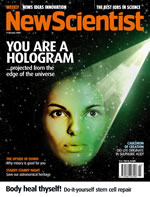Topic: SCIENCE - on January 17, 2009 at 11:07:00 AM CET
Our world may be a giant hologram
The story begins at the German experiment GEO600, a laser inteferometer looking for gravity waves. For years, researchers there have been locating and eliminating sources of interference and noise from the experiment (they have not yet seen a gravity wave). For months they have been puzzling over a source of noise they could not explain. Then Craig Hogan, a Fermilab physicist, approached them with a possible answer: that GEO600 may have stumbled upon a fundamental limit where space-time stops behaving like a smooth continuum and instead dissolves into "grains." The "holographic principle" suggests that the universe at small scales would be "blurry," its smallest features far larger than Planck scale, and possibly accessible to current technology such as the GEO600. The holographic principle, if borne out, could help distinguish among competing theories of quantum gravity, but "We think it's at least a year too early to get excited," the lead GEO600 scientist said.

... Comment










